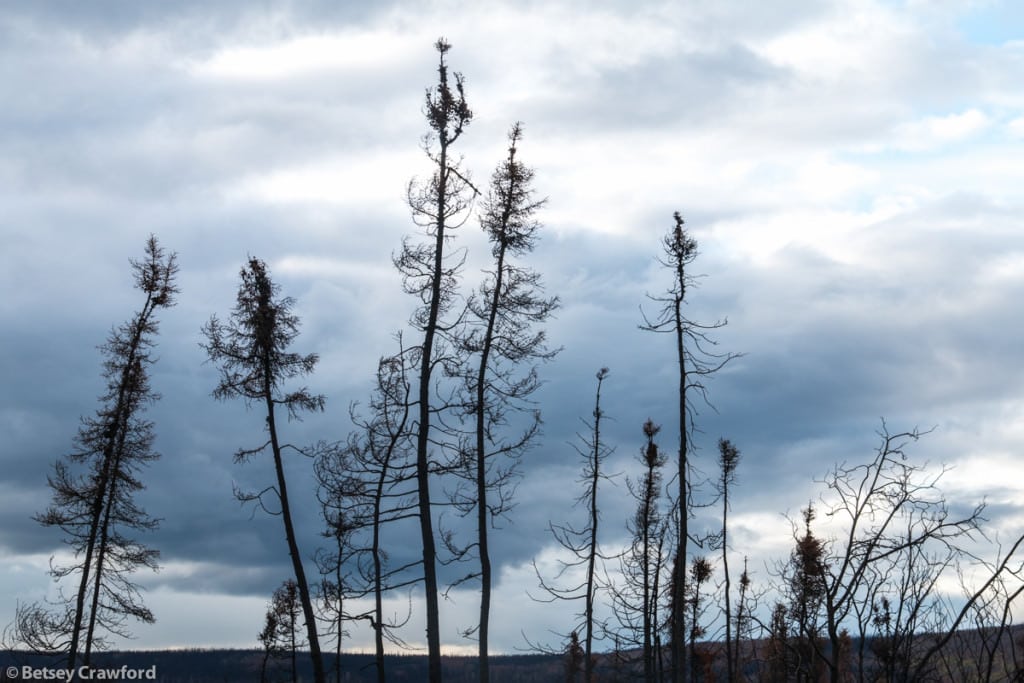 On the way north last summer we were stopped by a wildfire in British Columbia. It had jumped Route 97, and the RV park where we spent the night slowly filled with people who had kept driving and been turned back. The manager warned us that we might be roused from sleep and asked to evacuate further south, but late the next morning we were allowed to drive through, still in a fog of smoke. I’d never seen a forest right after a fire. The pitch black trunks were stark along the road, grayer farther back, where the dense haze softened them. Smoke rose slowly from the still smoldering black ground, rough with burned plants. Nothing green was left. I was longing to stop for a picture, but we were the first in line after the pilot car guiding us, there to keep crazy people from stopping in a still smoldering fire to take pictures. But that vertical black and shifting gray landscape was unforgettable.
On the way north last summer we were stopped by a wildfire in British Columbia. It had jumped Route 97, and the RV park where we spent the night slowly filled with people who had kept driving and been turned back. The manager warned us that we might be roused from sleep and asked to evacuate further south, but late the next morning we were allowed to drive through, still in a fog of smoke. I’d never seen a forest right after a fire. The pitch black trunks were stark along the road, grayer farther back, where the dense haze softened them. Smoke rose slowly from the still smoldering black ground, rough with burned plants. Nothing green was left. I was longing to stop for a picture, but we were the first in line after the pilot car guiding us, there to keep crazy people from stopping in a still smoldering fire to take pictures. But that vertical black and shifting gray landscape was unforgettable.
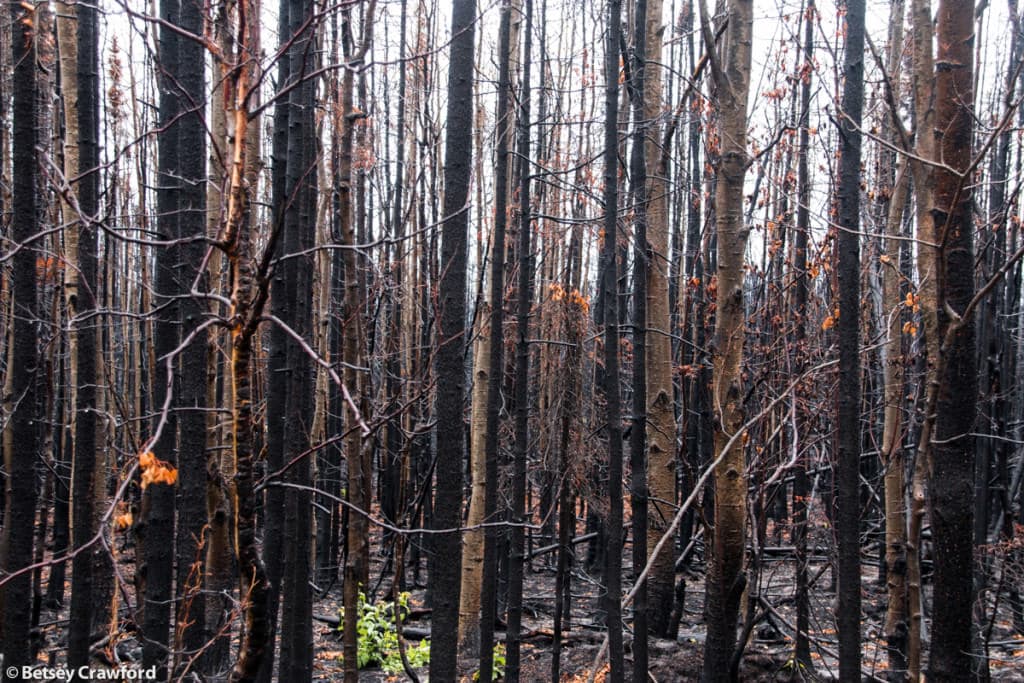 Many people associate wildfire with devastation, and it was easy to see why, driving through that suddenly barren and spooky landscape. The power of a forest or wildland fire can be terrifying, the destruction incomprehensible. Easy, also, to see why earlier forest service personnel felt that as many fires should be fought as possible. But we have slowly learned the costly lessons of trying to outflank nature. Without fires, there would eventually be no forest. Fires keep the lands they burn healthy, whether they are forests, meadows, or deserts. A lot of the strength of current wildfires is fueled by centuries of fire suppression — leaving the forest full of flammable material: crowded, aging trees, heaps of fallen branches, dried shrubs, not enough green, succulent growth on the forest floor to slow new fires.
Many people associate wildfire with devastation, and it was easy to see why, driving through that suddenly barren and spooky landscape. The power of a forest or wildland fire can be terrifying, the destruction incomprehensible. Easy, also, to see why earlier forest service personnel felt that as many fires should be fought as possible. But we have slowly learned the costly lessons of trying to outflank nature. Without fires, there would eventually be no forest. Fires keep the lands they burn healthy, whether they are forests, meadows, or deserts. A lot of the strength of current wildfires is fueled by centuries of fire suppression — leaving the forest full of flammable material: crowded, aging trees, heaps of fallen branches, dried shrubs, not enough green, succulent growth on the forest floor to slow new fires.

2015 was both the hottest year on record and had the most wildfires. One of our fellow campers that night was returning home to Fairbanks, Alaska. “The whole state is on fire,” she told me. These days, more and more fires are allowed to burn unless they pose a hazard to life or property, and, once in Alaska, we saw plenty of evidence that a lot of the state had burned earlier in the summer. After our arrival in mid-July, the weather grew steadily wetter. But we passed vast stands of black trunks, often interspersed with swathes of lighter trunks from earlier fires, trunks that had shed their burnt bark and were weathering to a silvery gray.
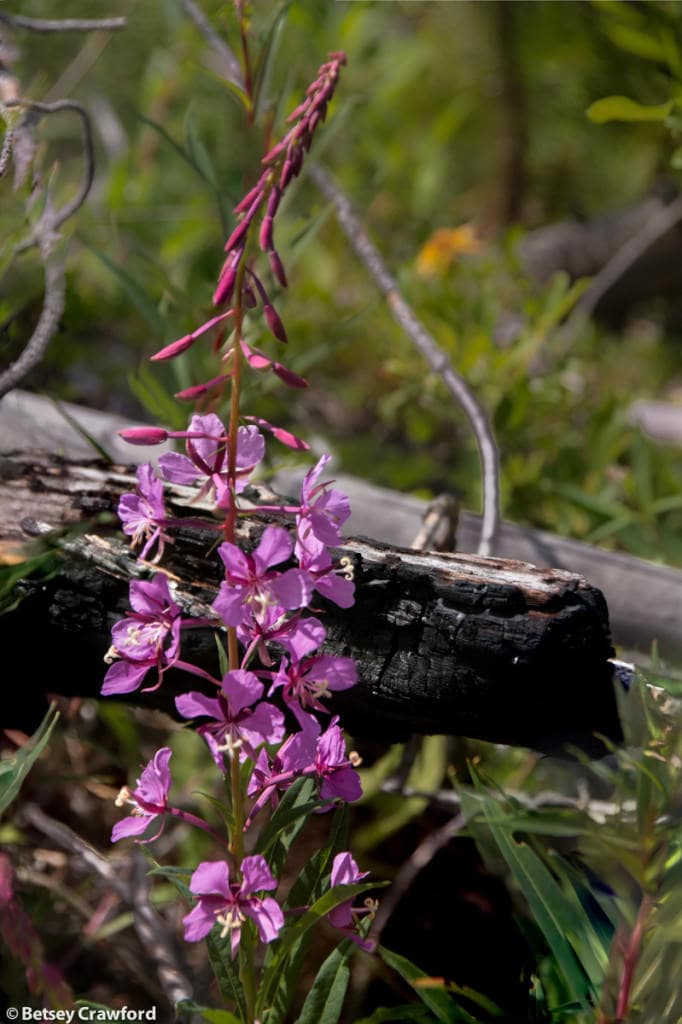
A wildfire doesn’t immediately leave behind a pretty landscape. Those blackened trunks can stand for years while the growth around them recovers. It takes decades for trees to grow tall enough to replace the forest. But a fire opens the ground to sun, eliminates competition from tree roots and shrubs, and its ash fills the soil with nutrients. New growth is almost instant. By the time we drove down Route 97 six weeks later, the ground under the burned trunks was a vivid green. Native Americans used controlled fires to create these conditions, because the extra nutritious new grasses and plants attracted wildlife, and made hunting easier.

The next arrivals are wildflowers, springing from seeds dormant for years, sometimes decades. In many areas deciduous trees sprout up, growing quickly, racing past the slow evergreens that will eventually outcompete them. During their long maturation, you will have years of glowing wildflowers. Then, depending on where you are, you may have years of aspen turning the mountainsides gold every fall, shimmering vivid green in the spring, their trunks silver above the snow in the winter. The conifers will slowly catch up, and take over, eventually blocking the light from the wildflowers and grasses, which will retreat into dormancy, waiting for the next fire to burn through and release them.
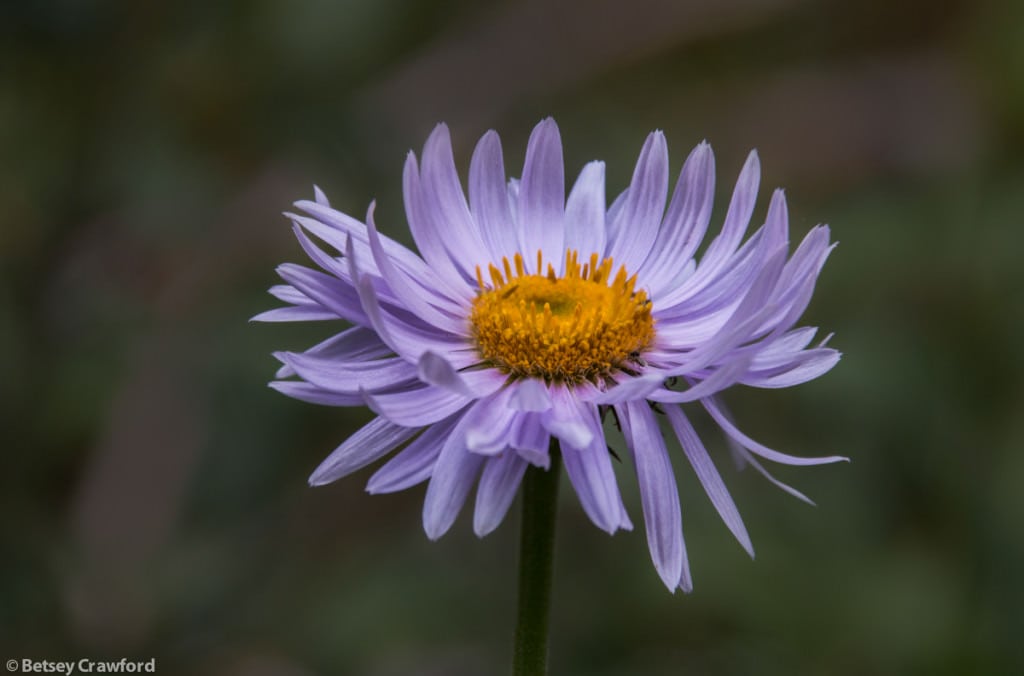
When I was in Banff, Alberta, I went into the visitors’ center to ask where I could find wildflowers. As soon as the friendly young woman said there had been a wildfire at Stanley Glacier in nearby Kootenay National Park, I was ready to go. The flowers accompanying this post are from that hike. Since I was so smitten with the flowers, I never took a picture of the terrain, which was full of three and four foot high lodgepole pines, lushly green and healthy. Around them grew fireweed, of course, mixed with wild orchids, and paintbrush in the most vivid colors I’ve ever seen. Columbine and fleabane were everywhere.
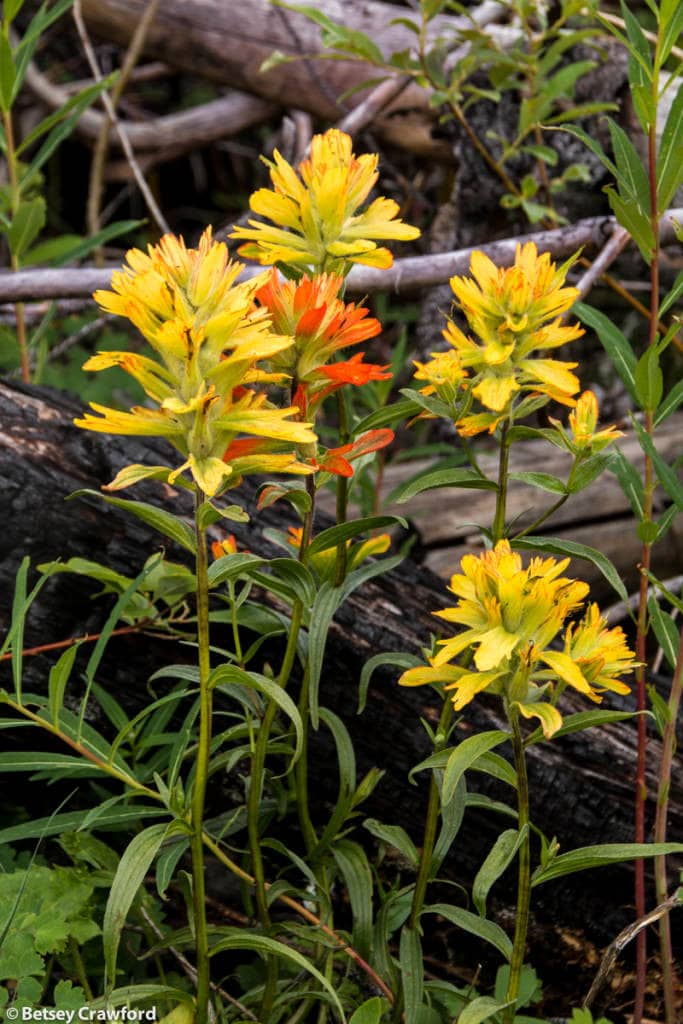
The fire happened in 2003, so it’s taken that long for the forest to get to 4’. We are used to fixing things quickly. If a house burns down, there can be a new one in months. If a forest burns down, it requires a very different mindset: rebuilding is the work of decades. A house is no good until it’s finished, but each stage of a growing forest is as vital as all the others. The wildflowers growing among the toddler trees at Stanley Glacier are just as much the forest as the trees that succeed them.
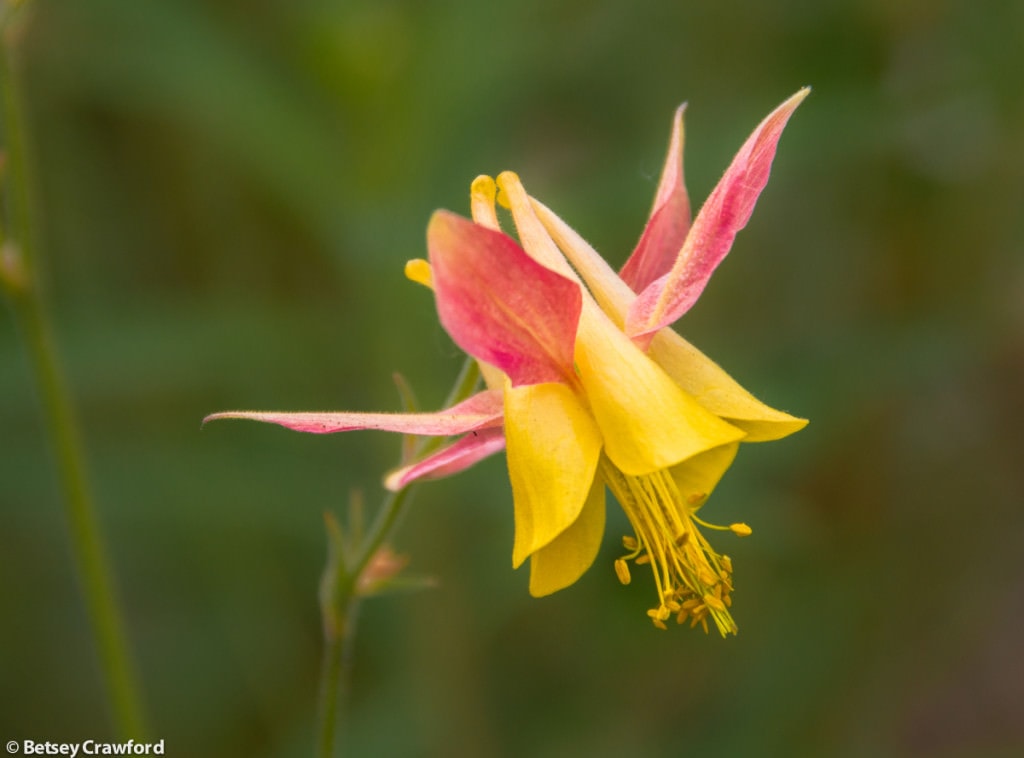
Life on earth is a ceaseless conversation. Growth, death, change, renewal. Fire, flowers, aspens, lodgepole pines, fire. Ashes, petals, bark. Fireweed next to blackened trunks, wild orchids among the baby pines. It’s an ancient dialectic that we interrupt at our peril, because we don’t comprehend the infinity of factors that go into the earth’s forces. It has taken from colonial times until recently to understand that interfering with wildfires damages everything we think we’re saving. We must when houses and people are at stake, but even then, suppression comes at at the cost of making the next fire hotter and more dangerous, the soil more unstable, mudslides more likely. One of the many complex challenges facing us as we assess our footprint on the planet.

Wonderful post, Betsey. We were up in Alaska last summer and saw some of the same places and many of the same wildflowers. Did three or four posts of our trip. With my interest in orchids the last picture in this post was especially interesting. Usually now named as Platanthera dilatata, it looks like the var. dilatata, which has a spur about equal the length of the lip. There are two other varieties one with a spur much longer than the lip and the other with a spur much shorter – probably different pollinators. This hybridizes rather freely with the green Platantheras. Did you notice the strong and beautiful scent?
Thanks so much, Ron. I look forward to reading your Alaska posts. I’m sorry to say I didn’t notice the orchid’s scent, but after your telling me this, I’ll be checking. And thank you for the new name. I’m always hoping someone will come by and set me right where necessary. I read an article about which name fireweed is going by, and stuck with epilobium because that seemed to be what people are still doing, at least for now.
“Life on earth is a ceaseless conversation.” SOOO wonderful… I love this post! So wise, so beautiful, so full of accepting grace… MLAA
Thanks, my dear. I love the idea that I show accepting grace at least some of the time!
Thanks Betsey – for more gorgeous photos and, compelling, illuminating words. What came to me was the fires that can go through our bodies and spirits too, burning down existing structures, making way for what’s next. I ws resently in a group of women (we were six). Three in the group had or have had cancer (all breast) and two with spouses who did. One image that came to mine was he was on a mesa surrounded by flames. Seems it’s part of our cycle. I’m grateful for it to allow new life and vivid color that comes through us too.
What a beautiful way to look at what seems, as with a forest, so damaging at first sight.
This is beautiful, Betsey. I’m so glad to be on board! –Laurie
Thank you, Laurie. So glad to have you here!
What a beautiful perspective on wildfires! Coming from CA they have always made me so sad to see the green mountains I love turned to black and grey. But you are right- they are a part of the big totality and harmony of all things and only in a short sighted, narrow perspective are they seen as a mistake. I love how you are able to capture the beauty in the whole process.
You stated it so well, the pictures are beautiful. Thank you, Betsey
Thanks so much, Doreen.
Thank you, Marcia. Yes, the dark forest makes me sad, too. At least until the wildflowers show up! The effects can last many years, too, though in the forest’s life it’s just minutes.
Again I learn and remember.
The Forest Service programs have not recognized the truth you tell. My years in Seattle and my understanding did not work together. But my biking all over Colorado has learned me finally that that FS bear had a destructive message.
Keep up my education.
Bruce
Thanks, Bruce. I can understand their impulse to fight as many fires as possible.